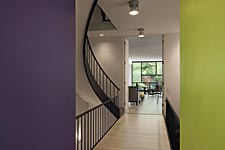 |
| A newly detailed bridge leads from the entrance to the living room, where a two-story Mondrianesque framework of windows overlooks the terraced garden. |
I’m not a coward about color,” says Mary Chait. But she does not get riotously over the top with it, either. She knows how to place it to give total impact to a minimalist setting with an otherwise monochromatic palette. Shades of juicy chartreuse, grape, and daffodil yellow animate the late 19th century four-story row house that she and her husband, Jon, the chief executive officer and chairman of the Hudson Highland Group, a global staffing and executive search firm, bought on the Gold Coast four years ago.
At the time, the interior of the main floor was a modernist study in white, a high-style rendition of mid-20th-century chic-aesthetically pure but a little chilly in spirit. Situated on the lower level, the kitchen was a dour study in black, with a small white dining room adjoining it. But the house offered what Mary, a volunteer for the Make-A-Wish Foundation and a former nurse, wanted most: light and possibilities for still more exposure. The Chaits then were living not far away in another row house on Elm Street with their daughter, Meredith, now 15. But due to the surroundings, darkness had descended. “All these high-rises and big trees were behind the house,” Mary explains, “so the sun never came in.” The new place had a terraced garden in back and a parking space; and it was situated next to a wide alley, an available light source that could also accommodate a basketball hoop for Meredith. The Chaits’ real-estate agent put them in touch with Paul Florian, the principal of Florian Architects, who had renovated the Elm Street house for the previous owners-a design the Chaits had felt compelled to keep. Florian in turn suggested that they also contact the interior designer Jorge Romero.
Once the collaborators were assembled, it became clear that the plan for the new place would be contemporary, with a European influence. Before moving to Chicago, the Chaits had lived in Brussels for several years in a renovated coach house, where their previously traditional tastes (think chintz) underwent a change. “It was very modern,” Mary recalls. “Jon just likes the loft idea-open, airy, light, not too confining.”
The earlier renovation, Florian says, was done by the Chicago architect Arthur Myrum, who died in 1980. He had eliminated most of the Victorian references from the original design of the first and lower floors, and on this project, those areas were again the focus. “They wanted something that had a bit of an industrial feeling,” Florian recalls, “but they realized that in this neighborhood, it wasn’t appropriate to have it as raw or unfinished as a loft.” The group decided that color would define the walls framing the passageway into the living room-one a lime green, the other a cool purple. Replacing parquet, bleached white oak floors now reflect light and lend a sense of spaciousness to a house that is only 15 feet wide.
To create a threshold and moderate the visual sweep of the space, the passageway was redetailed to resemble a bridge. “We framed it in steel,” explains Robert Sellars, the project architect, “and changed the direction of the planks.” Painting the railings charcoal gray, Romero says, gave them a sculptural quality against the white walls of the passageway.
Straight ahead is a two-story framework of windows-a Mondrianesque design of panes in various sizes, some gridded and others translucent, outlined in black metal. “Some of our work goes back to the principles of de Stijl, a Dutch movement that used components of modernism in a decorative way,” Florian explains. “The window is more than the absence of a wall and a system to hold glass. It’s an object to be enjoyed aesthetically as well as simply to be looked through.” The gridded panes were placed to obscure exterior wires and alley views; the clear, to frame sections of the garden.
To enhance the view of the double-height windows and open up the lower floor to the garden, Florian reduced the length of the living room by about five feet and re-positioned the back stairway against the east wall. He custom designed the new stairs in steel with cable along the sides and a platform of Burlington stone that extends outdoors. He used the same materials for the fireplace mantel and surround.
“Everything repeats in a fairly rigorous way,” Florian says, explaining the internal unities of the design, among them glass of the same thickness for the stair railing in back, for the inset shelves, and for the rectangular window inserted between the upper and lower floors. Two windows on the west side of the house allow light to filter down through the floor window to the kitchen below, where a lone goldfish in a bowl on the counter swims in circles.
“Glass is stronger than a wood plank if it’s well supported,” Florian says. Here it holds a Philippe Starck table and chairs, a prior purchase by the Chaits from Luminaire. Among the new furnishings that Mary and Romero selected are a Lorin sofa, chair, and bench, covered in shades of ecru, from the Bright Group line. For the wall behind the furnishings, Romero suggested an ice blue. “It’s a soft, soothing color,” he says. A series of small steel sconces with halogen bulbs illuminate the setting and accent the height of the room.
The painting on the opposite wall above the fireplace is an abstract acrylic on canvas by Claire MacCauliffe, who attended CalArts with Mary’s sister. “It has worked everywhere we’ve lived,” Mary says of this movable energy source in bright yellow.
“There’s a big difference between the two sides of the house,” Romero points out. “It’s asymmetrical, which is more of a modern approach.” That is true of the lower level, as well, where with walls removed a large kitchen and dining area now opens onto the garden. Initially, for Mary, the old kitchen presented the greatest challenge in the renovation. “It was like a dungeon,” she says. “It had black cabinets, black everything.”
Florian sent Mary, a serious cook, and Romero to Arclinea Chicago to investigate kitchen designs, and they came back committed to cabinets and appliances in stainless steel and in a chartreuse lacquer. For the countertops, Mary and Romero chose statuary marble. “It’s the same marble that Michelangelo used for David,” Romero explains. “It’s the whitest of the marbles and has beautiful gray veining.” Sealed properly, he says, it is quite practical. To create a greater sense of height in the kitchen area and to incorporate track lighting, Florian excavated the spaces between the floor joists above.
Nearby, surrounding a glass-topped table from Ligne Roset, are Epic chairs from One Source covered in a synthetic leather called Neither Hide nor Hair. Romero de-signed a bench to fit beneath the stairs-a convenient space where Meredith stores some of her athletic shoes. In addition to basketball, she plays ice hockey and golf, and Mary sometimes manages her teams. Meredith keeps her 200 teddy bears elsewhere, in plain sight.
After all was said and done, though, Mary decided that there was no need to hold still. That grape shade had started to seem a little dreary. So not long ago, after these photographs were taken, she insisted that her color-me-purple period had come to an end, and it was in with a luscious, reverberating tangerine.
|
Photograph: Barbara Karant
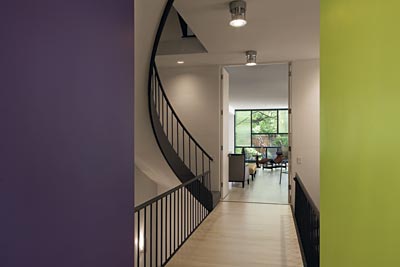 |
| A newly detailed bridge leads from the entrance to the living room, where a two-story Mondrianesque framework of windows overlooks the terraced garden. |
|
Photograph:Chris Guillen
 |
|
The limestone exterior
|
|
Photograph: Barbara Karant
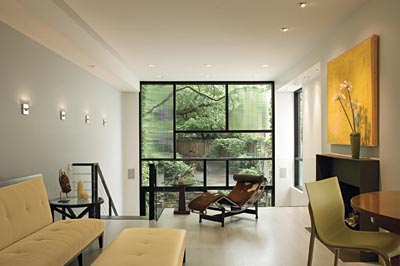 |
|
At one end of the living room
|
|
Photograph: Barbara Karant
 |
| A glass panel holding a table and chairs by Philippe Starck allows light to filter down to the kitchen. |
|
Photograph: Barbara Karant
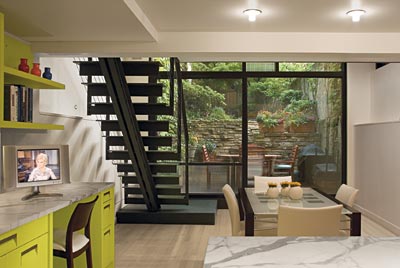 |
|
Photograph: Barbara Karant
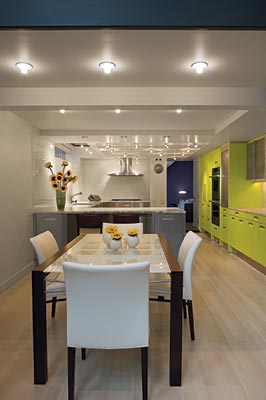 |
| The kitchen, in stainless steel and chartreuse lacquer with marble countertops, is an Arclinea design. |
|
Photograph: Barbara Karant
 |
| The garden in back is a spacious, private bower. |
Photography by Barbara Karant
Acme Marble & Granite Company
4750 South Maplewood Avenue; 773-523-0712
The honed white statuary marble for the kitchen countertops
Arclinea Chicago (Aaron Wilson)
314 West Superior Street; 312-335-3855
The kitchen design and cabinetry
Belstone
1439 West Hubbard Street; 312-421-8500
The Burlington stone for the staircase and the fireplace
Bernhardt
1600 Merchandise Mart; 312-832-1122
The Sheridan end table in the living room
Bright Group
6166 Merchandise Mart; 312-822-0177
The Lorin sofa, chair, and bench in the living room
European Ornamental Iron Work (Michael Pietanza)
408 Domenic Court, Franklin Park; 847-595-6606
The steel stairs, the railing system, and the fireplace surround
Florian Architects, Ltd. (Paul Florian, principal, and Robert Sellars, project architect)
432 North Clark Street, Suite 200; 312-670-2220
The architects
Hardt Electric
4909 North Elston Avenue; 773-685-2200
The electrical contractor
HBF Furniture & Textiles
387 Merchandise Mart; 312-222-2698
Upholstery
Ligne Roset
56 East Walton Street; 312-867-1207
The dining table
Luminaire
301 West Superior Street; 312-664-9582
The Philippe Starck table and chairs in the living room.
Manifesto
755 North Wells Street; 312-664-0733
The Le Corbusier chaise longue
Morr Sharp Associates
17 North State Street, Suite 1800; 312-986-1515
Lighting fixtures
One Source
347 Merchandise Mart; 312-961-8657
The Fiesta Collection dining room chairs by Index
Jorge Romero Design (Jorge Romero)
3400 North Lake Shore Drive; 773-975-3544
The interior designer
Senffner & Associates (Jim Senffner)
900 North Franklin Street; 312-440-2308
The structural engineer
Service Glass
4161 South Morgan Street; 312-726-5050
The storefront window system
Sylvester Construction (Barry Sylvester)
2742 North Lincoln Avenue; 773-281-6094
The general contractor
Tech Lighting
300 West Superior Street; 312-642-2190
The lighting in the kitchen.


